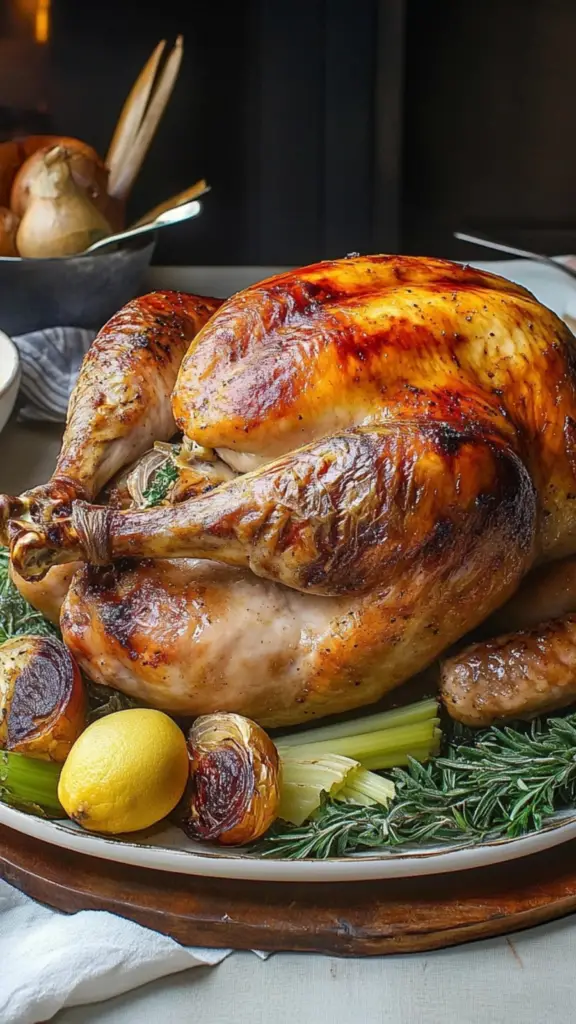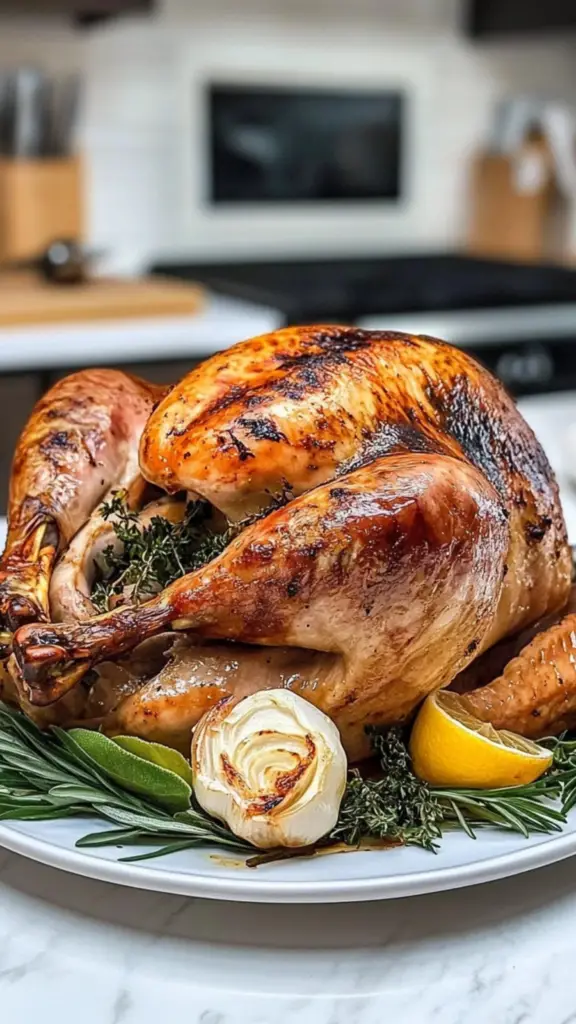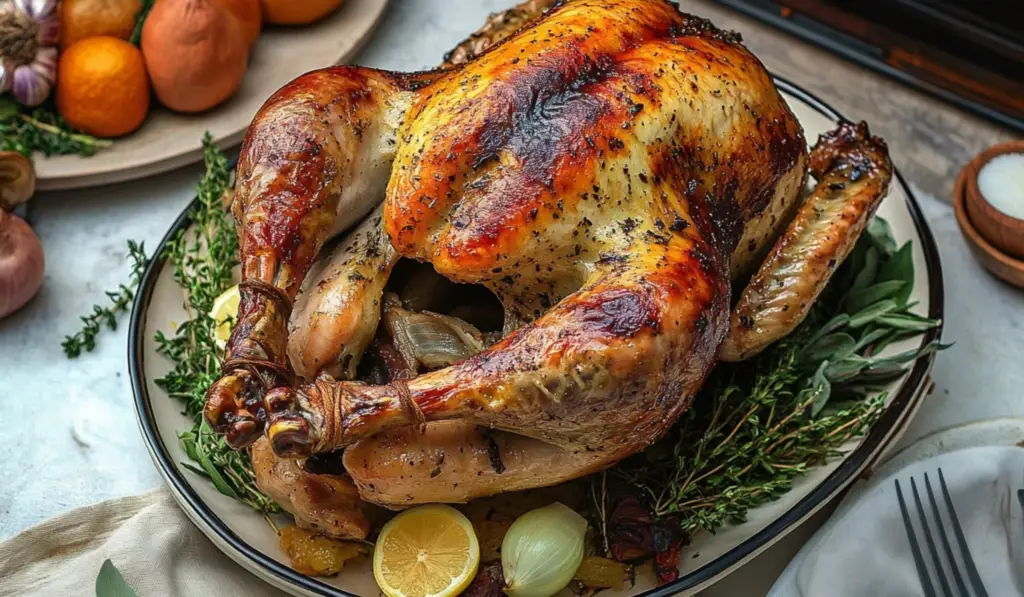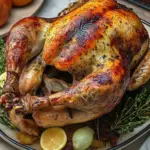When it comes to preparing turkey, achieving the perfect balance between a crispy, golden skin and juicy, flavorful meat can often be a challenge. The traditional roasting methods can sometimes result in dry meat, especially in the breast area, which tends to cook faster than the rest of the bird. Enter the Mayonnaise Roasted Turkey—a simple yet revolutionary technique that guarantees a turkey so tender, flavorful, and moist that it will become your go-to recipe for every holiday or special meal.

Mayonnaise Roasted Turkey: A Flavorful and Juicy Delight for Any Occasion
When it comes to preparing turkey, achieving the perfect balance between a crispy, golden skin and juicy, flavorful meat can often be a challenge. The traditional roasting methods can sometimes result in dry meat, especially in the breast area, which tends to cook faster than the rest of the bird. Enter the Mayonnaise Roasted Turkey—a simple yet revolutionary technique that guarantees a turkey so tender, flavorful, and moist that it will become your go-to recipe for every holiday or special meal.
- Prep Time: 10 minutes
- Cook Time: 4 hours
- Total Time: 4 hours 10 minutes
- Yield: 1 Whole Turkey (serves 6-8) 1x
- Category: Main Course, Holiday, Dinner
- Method: Roasting
- Cuisine: American, Thanksgiving, Holiday Meals
- Diet: Gluten Free
Ingredients
- Whole Turkey: The size of the turkey will vary depending on how many people you’re serving, but it’s important to ensure that the bird is fully thawed before you begin preparing it. A frozen turkey will result in uneven cooking, so make sure to plan ahead for proper thawing time.
- 1 ½ cups of Mayonnaise: This is the star ingredient of the recipe. The mayonnaise not only helps the herbs stick to the skin but also forms a moisture-locking barrier that prevents the turkey from drying out. The fat content in the mayonnaise ensures that the meat stays tender and juicy, even as it roasts.
- 2 tbsp Fresh Sage, Chopped: Sage is a classic herb that complements the flavor of turkey perfectly. Its earthy, slightly peppery flavor adds depth to the turkey and works wonderfully with the richness of the mayonnaise. Fresh sage is preferred for its aromatic quality, but dried sage can be used in a pinch (just reduce the quantity).
- 1 tbsp Fresh Rosemary, Chopped: Rosemary has a pine-like aroma and a slightly pungent, woody flavor. It pairs beautifully with the other herbs and adds a fragrant, savory note to the turkey. Fresh rosemary is ideal for this recipe, but dried rosemary can also be substituted if needed.
- 8–10 Sprigs Fresh Thyme, Stems Removed: Thyme has a lemony, slightly floral flavor that balances the richness of the turkey. It’s a versatile herb that blends well with the other seasonings and adds a delicate fragrance to the meat. As with the other herbs, fresh thyme is best, but dried thyme can be used if necessary.
- Salt and Pepper: These essential seasonings are crucial for bringing out the natural flavors of the turkey and the herbs. Be sure to season the turkey generously with salt and pepper, especially since the mayo will enhance the flavor, not overpower it.
Instructions
Step 1: Prepare the Turkey
Begin by ensuring that your turkey is completely thawed. A frozen turkey will not cook evenly, and the skin won’t crisp up as it should. To speed up the thawing process, you can place the turkey in the refrigerator for a few days ahead of time. If you’re short on time, you can also thaw it in cold water (make sure the turkey is in a sealed plastic bag to avoid water contamination).
Once the turkey is thawed, dry it thoroughly with paper towels. This helps the mayonnaise rub adhere better and ensures that the skin becomes crispy during the roasting process. After drying, season the turkey generously with salt and pepper, both inside the cavity and on the skin. This step helps to flavor the meat and create a savory foundation for the mayo rub.
Step 2: Preheat the Oven
Next, preheat your oven to 450°F (230°C). The high temperature at the beginning helps to sear the turkey, giving the skin a beautiful golden-brown color. Once the oven reaches the desired temperature, prepare your roasting pan by lightly greasing it with olive oil or non-stick cooking spray. This ensures that the turkey doesn’t stick during the roasting process and helps achieve an even cook.
Step 3: Prepare the Mayo Herb Rub
In a small bowl, combine the 1 ½ cups of mayonnaise with the freshly chopped herbs (sage, rosemary, and thyme). Add a pinch of salt and pepper to taste, and stir the mixture until the herbs are well distributed. The mayonnaise serves as both a flavor carrier and a moisture-locking agent, so make sure it’s applied generously.
Step 4: Stuff the Turkey
Before you apply the mayo rub, stuff the turkey cavity with aromatic vegetables like a sweet onion, garlic cloves, celery stalks, and lemon halves. These ingredients will infuse the meat with additional flavors while it roasts. The onion and garlic add sweetness, the celery contributes a mild herbal note, and the lemon provides a refreshing citrus flavor that complements the richness of the turkey.
Step 5: Apply the Mayo Herb Rub
Once the turkey is stuffed, take the mayo herb mixture and generously coat the entire turkey. Be sure to cover the skin evenly with the mayo rub, making sure the herbs stick to the turkey’s surface. The mayo will help retain moisture while roasting, while the herbs infuse the skin with a delicious fragrance. Don’t skimp on the mayo—it’s crucial for achieving that crispy, flavorful skin.
Step 6: Roast the Turkey
Place the turkey in the preheated oven and roast for 20 minutes at 450°F (230°C). This high heat helps to create an initial sear on the skin, giving it a golden-brown color. After 20 minutes, reduce the oven temperature to 350°F (175°C) and continue roasting for another 2.5 to 3.5 hours, depending on the size of the turkey. The general guideline is to roast the turkey for about 13-15 minutes per pound.
To check for doneness, insert a meat thermometer into the thickest part of the turkey’s thigh or breast. The turkey is done when the internal temperature reaches 165°F (74°C). If the skin begins to brown too much, you can cover the exposed areas with aluminum foil to prevent over-browning while the turkey continues to cook.
Step 7: Rest the Turkey
Once your turkey has reached the desired internal temperature, remove it from the oven and let it rest for 15-20 minutes before carving. This allows the juices to redistribute throughout the meat, keeping it moist and flavorful. Don’t skip this step—it’s essential for achieving juicy turkey.
Step 8: Make the Gravy
While the turkey is resting, you can use the pan drippings to make a rich, flavorful gravy. To do this, whisk a few tablespoons of flour with chicken stock to create a slurry. Add this mixture to the pan drippings and simmer over medium-low heat until the gravy reaches your desired thickness. If you prefer a thinner gravy, you can add more chicken stock until it reaches the desired consistency. Once the gravy is done, you’re ready to serve.
Notes
- Herb Substitutes: If you’re missing any of the herbs in the recipe, feel free to experiment with others. Thyme, oregano, or even tarragon can all work well in place of sage and rosemary.
- Add Heat: For a little extra kick, you can incorporate red pepper flakes or minced jalapeños into the mayonnaise mixture. This adds a subtle spice that balances the richness of the turkey.
- Gravy Variations: If you prefer a creamier gravy, you can add a splash of heavy cream to the pan drippings after thickening it with flour. This creates a velvety gravy that’s perfect for pouring over the turkey and mashed potatoes.
- Make-Ahead Gravy: You can make the gravy ahead of time and store it in the fridge until you’re ready to serve. Reheat it over low heat, adding a little more chicken stock if necessary.
- Leftover Turkey: The leftovers from this recipe can be used in a variety of dishes. Make turkey sandwiches, soups, salads, or casseroles—there’s no shortage of creative ways to use leftover turkey.
At the heart of this method is mayonnaise, which is not only used to add richness and flavor but also acts as an insulating agent. When applied to the turkey skin, mayonnaise locks in moisture, allowing the turkey to roast evenly while creating a crispy, golden exterior. Combined with fresh herbs like sage, rosemary, and thyme, this recipe results in a turkey that’s full of savory flavor and has the perfect texture. Whether you’re preparing for Thanksgiving, a family gathering, or any special occasion, this Mayonnaise Roasted Turkey will surely steal the spotlight.
The Appeal of Mayonnaise Roasted Turkey
Turkey can often be dry, especially if it’s overcooked, but the Mayonnaise Roasted Turkey solves that problem by sealing in moisture with the creamy mayonnaise. The fat in the mayonnaise insulates the meat, ensuring that it stays moist throughout the cooking process. As the turkey roasts, the mayo forms a flavorful crust, providing a crispy, golden skin that’s packed with herbaceous flavors. The rich mayonnaise also helps the herbs adhere to the skin, ensuring every bite is filled with savory notes of sage, rosemary, and thyme.
This method also cuts down on preparation time because the mayo acts as both a basting agent and a seasoning, eliminating the need for frequent basting or other complicated techniques. Additionally, the recipe is highly versatile, allowing you to customize the herbs or seasoning to suit your preferences. Whether you’re a beginner cook or an experienced chef, this recipe is easy to follow and delivers consistent, outstanding results.
Ingredients Breakdown: What You Need for a Perfect Mayonnaise Roasted Turkey
The ingredients for Mayonnaise Roasted Turkey are simple, but each one plays a crucial role in creating a moist, flavorful roast. Here’s a breakdown of the key components:
- Whole Turkey: The size of the turkey will vary depending on how many people you’re serving, but it’s important to ensure that the bird is fully thawed before you begin preparing it. A frozen turkey will result in uneven cooking, so make sure to plan ahead for proper thawing time.
- 1 ½ cups of Mayonnaise: This is the star ingredient of the recipe. The mayonnaise not only helps the herbs stick to the skin but also forms a moisture-locking barrier that prevents the turkey from drying out. The fat content in the mayonnaise ensures that the meat stays tender and juicy, even as it roasts.
- 2 tbsp Fresh Sage, Chopped: Sage is a classic herb that complements the flavor of turkey perfectly. Its earthy, slightly peppery flavor adds depth to the turkey and works wonderfully with the richness of the mayonnaise. Fresh sage is preferred for its aromatic quality, but dried sage can be used in a pinch (just reduce the quantity).
- 1 tbsp Fresh Rosemary, Chopped: Rosemary has a pine-like aroma and a slightly pungent, woody flavor. It pairs beautifully with the other herbs and adds a fragrant, savory note to the turkey. Fresh rosemary is ideal for this recipe, but dried rosemary can also be substituted if needed.
- 8-10 Sprigs Fresh Thyme, Stems Removed: Thyme has a lemony, slightly floral flavor that balances the richness of the turkey. It’s a versatile herb that blends well with the other seasonings and adds a delicate fragrance to the meat. As with the other herbs, fresh thyme is best, but dried thyme can be used if necessary.
- Salt and Pepper: These essential seasonings are crucial for bringing out the natural flavors of the turkey and the herbs. Be sure to season the turkey generously with salt and pepper, especially since the mayo will enhance the flavor, not overpower it.
Step-by-Step Instructions: How to Roast the Perfect Turkey
Now that you have all the ingredients, let’s go through the step-by-step process of making Mayonnaise Roasted Turkey. This method is simple, but the results are truly impressive.
Step 1: Prepare the Turkey
Begin by ensuring that your turkey is completely thawed. A frozen turkey will not cook evenly, and the skin won’t crisp up as it should. To speed up the thawing process, you can place the turkey in the refrigerator for a few days ahead of time. If you’re short on time, you can also thaw it in cold water (make sure the turkey is in a sealed plastic bag to avoid water contamination).
Once the turkey is thawed, dry it thoroughly with paper towels. This helps the mayonnaise rub adhere better and ensures that the skin becomes crispy during the roasting process. After drying, season the turkey generously with salt and pepper, both inside the cavity and on the skin. This step helps to flavor the meat and create a savory foundation for the mayo rub.
Step 2: Preheat the Oven
Next, preheat your oven to 450°F (230°C). The high temperature at the beginning helps to sear the turkey, giving the skin a beautiful golden-brown color. Once the oven reaches the desired temperature, prepare your roasting pan by lightly greasing it with olive oil or non-stick cooking spray. This ensures that the turkey doesn’t stick during the roasting process and helps achieve an even cook.
Step 3: Prepare the Mayo Herb Rub
In a small bowl, combine the 1 ½ cups of mayonnaise with the freshly chopped herbs (sage, rosemary, and thyme). Add a pinch of salt and pepper to taste, and stir the mixture until the herbs are well distributed. The mayonnaise serves as both a flavor carrier and a moisture-locking agent, so make sure it’s applied generously.
Step 4: Stuff the Turkey
Before you apply the mayo rub, stuff the turkey cavity with aromatic vegetables like a sweet onion, garlic cloves, celery stalks, and lemon halves. These ingredients will infuse the meat with additional flavors while it roasts. The onion and garlic add sweetness, the celery contributes a mild herbal note, and the lemon provides a refreshing citrus flavor that complements the richness of the turkey.
Step 5: Apply the Mayo Herb Rub
Once the turkey is stuffed, take the mayo herb mixture and generously coat the entire turkey. Be sure to cover the skin evenly with the mayo rub, making sure the herbs stick to the turkey’s surface. The mayo will help retain moisture while roasting, while the herbs infuse the skin with a delicious fragrance. Don’t skimp on the mayo—it’s crucial for achieving that crispy, flavorful skin.
Step 6: Roast the Turkey
Place the turkey in the preheated oven and roast for 20 minutes at 450°F (230°C). This high heat helps to create an initial sear on the skin, giving it a golden-brown color. After 20 minutes, reduce the oven temperature to 350°F (175°C) and continue roasting for another 2.5 to 3.5 hours, depending on the size of the turkey. The general guideline is to roast the turkey for about 13-15 minutes per pound.
To check for doneness, insert a meat thermometer into the thickest part of the turkey’s thigh or breast. The turkey is done when the internal temperature reaches 165°F (74°C). If the skin begins to brown too much, you can cover the exposed areas with aluminum foil to prevent over-browning while the turkey continues to cook.
Step 7: Rest the Turkey
Once your turkey has reached the desired internal temperature, remove it from the oven and let it rest for 15-20 minutes before carving. This allows the juices to redistribute throughout the meat, keeping it moist and flavorful. Don’t skip this step—it’s essential for achieving juicy turkey.
Step 8: Make the Gravy
While the turkey is resting, you can use the pan drippings to make a rich, flavorful gravy. To do this, whisk a few tablespoons of flour with chicken stock to create a slurry. Add this mixture to the pan drippings and simmer over medium-low heat until the gravy reaches your desired thickness. If you prefer a thinner gravy, you can add more chicken stock until it reaches the desired consistency. Once the gravy is done, you’re ready to serve.
Serving Suggestions
Once the turkey is carved, serve it with your favorite side dishes. Classic options like mashed potatoes, roasted vegetables, and stuffing are always a hit. For a lighter option, try pairing the turkey with a fresh salad or some steamed green beans. The rich, flavorful gravy can be poured over the turkey and sides for an added layer of indulgence.
The Mayonnaise Roasted Turkey is not just for special occasions—it’s perfect for any family dinner or gathering where you want to impress your guests with a juicy, flavorful bird. The creamy mayonnaise rub locks in moisture, and the fresh herbs elevate the flavor, making this turkey a guaranteed crowd-pleaser.
Tips and Variations
- Herb Substitutes: If you’re missing any of the herbs in the recipe, feel free to experiment with others. Thyme, oregano, or even tarragon can all work well in place of sage and rosemary.
- Add Heat: For a little extra kick, you can incorporate red pepper flakes or minced jalapeños into the mayonnaise mixture. This adds a subtle spice that balances the richness of the turkey.
- Gravy Variations: If you prefer a creamier gravy, you can add a splash of heavy cream to the pan drippings after thickening it with flour. This creates a velvety gravy that’s perfect for pouring over the turkey and mashed potatoes.
- Make-Ahead Gravy: You can make the gravy ahead of time and store it in the fridge until you’re ready to serve. Reheat it over low heat, adding a little more chicken stock if necessary.
- Leftover Turkey: The leftovers from this recipe can be used in a variety of dishes. Make turkey sandwiches, soups, salads, or casseroles—there’s no shortage of creative ways to use leftover turkey.

Final Thoughts
The Mayonnaise Roasted Turkey is an easy, foolproof method for achieving a flavorful, juicy turkey with a crispy, golden skin. By using mayonnaise as a base, you not only lock in moisture but also create a delicious layer of flavor from the fresh herbs. Whether you’re making it for Thanksgiving, Christmas, or any special occasion, this recipe will quickly become a favorite in your household. So why not give it a try? With minimal effort and maximum flavor, your next turkey roast will be a success every time.




